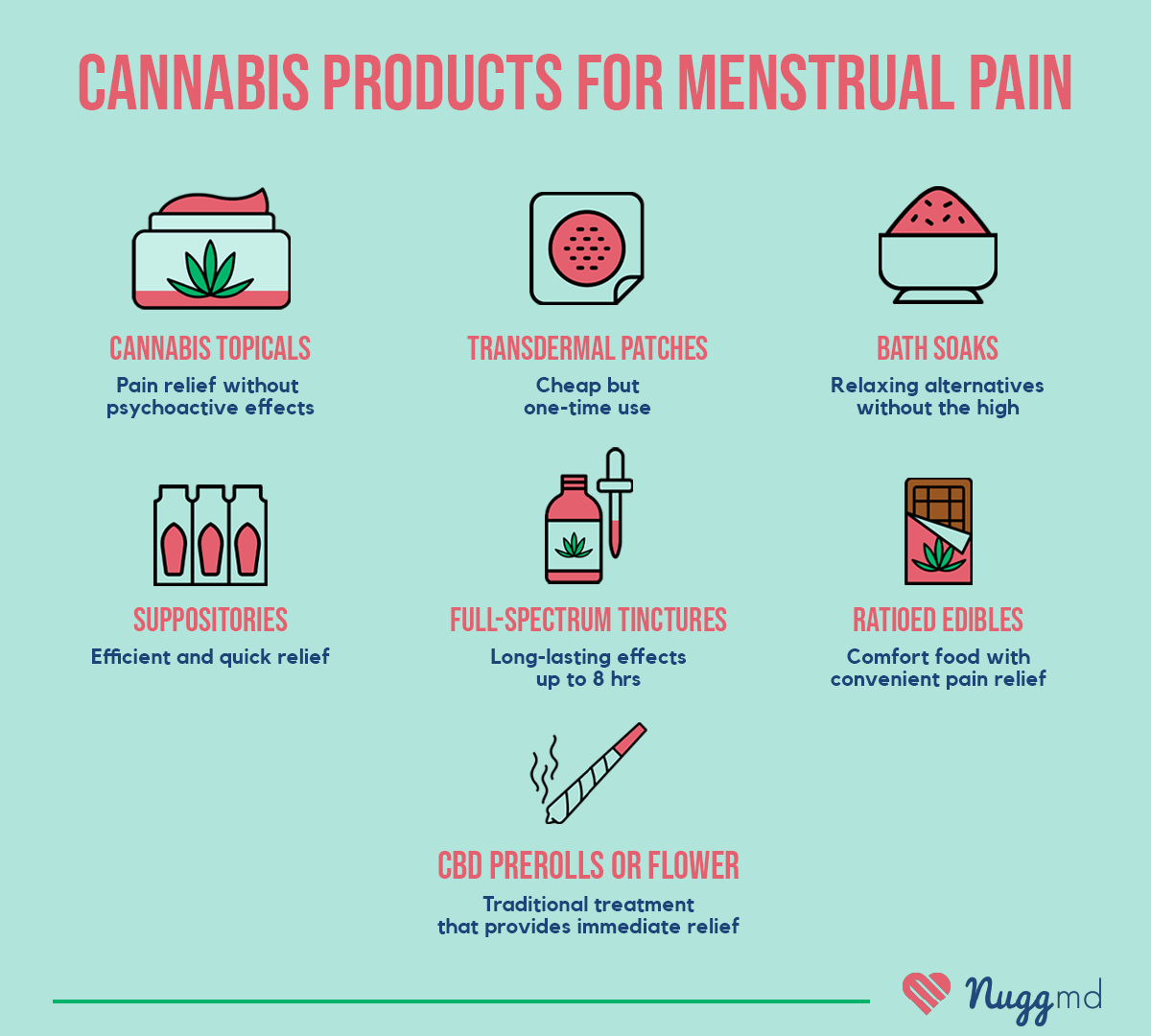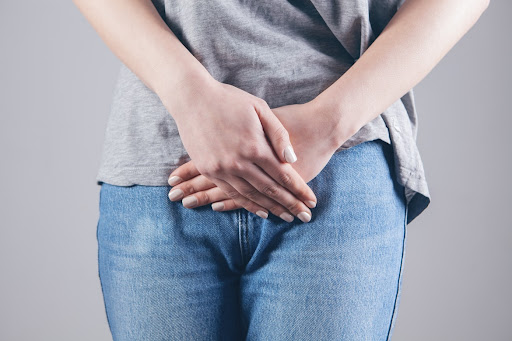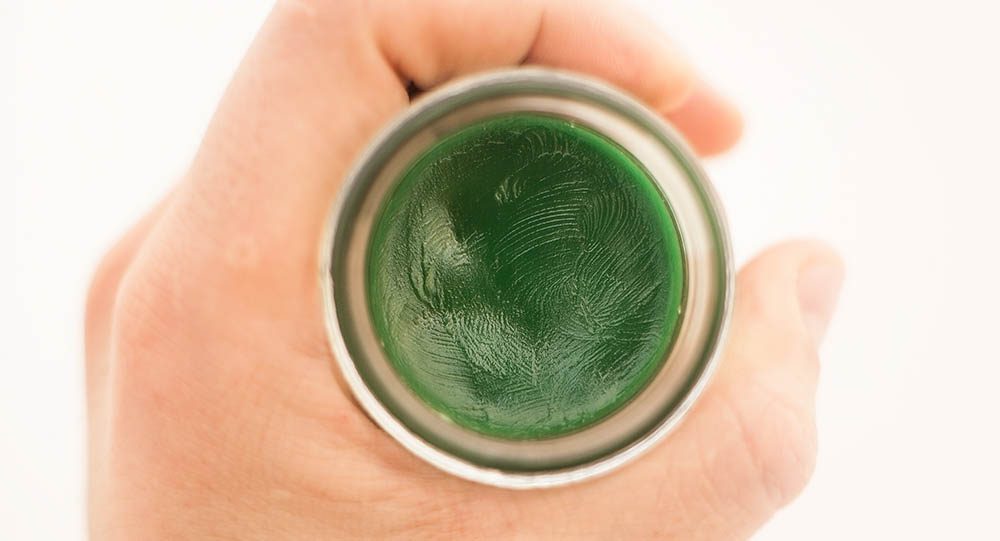Individuals have used cannabis for centuries to relieve symptoms of pain. Looking at the clinical evidence, studies have shown that various cannabinoids and cannabinoid ratios may alleviate the painful effects of various ailments, from migraines1 to cancer treatments2 and neurological disorders.3
Because of its potential pain-relieving properties, many cannabis users have wondered: “Does weed help with menstrual cramps?”
Let’s find out.
What Causes Menstrual Cramps
Menstrual cramps (dysmenorrhea) are painful period contractions ranging from mildly annoying dull aches to painful, debilitating throbbing.
The chemical hormone prostaglandin is involved in menstrual cramps. Prostaglandin influences physiological processes like pain and inflammation and causes the uterus to inflame and contract.
It forms from enzymes in the body called cyclooxygenase (COX), found in places like the gastrointestinal tract, and sites of inflammation, like the uterus, during menstruation.4
The uterus contracts throughout the menstrual cycle. It can happen during the luteal phase when the uterus lining is thick, preparing to support pregnancy or be released. It also contracts during menstruation when the uterus lining is shedding – think premenstrual syndrome (PMS).
If the uterus muscle contracts hard enough, it can pressure nearby blood vessels and cut off oxygen to the muscle tissue. This lack of oxygen is what triggers the pain. Bodies that produce higher levels of prostaglandin have more painful menstrual cramps.
Period pain can feel like pain or pressure on the abdominal, lower back, hips, and thighs, and it can be accompanied by nausea, vomiting, fatigue, or diarrhea. Some people who experience intense levels of dysmenorrhea can have their daily routines adversely affected or completely derailed by the pain and accompanying symptoms.
There are two different types of dysmenorrhea:
- Primary dysmenorrhea, or reoccurring cramps, can happen each cycle and last for 12-72 hours. The patterns of cramps can change throughout the uterus’s lifecycle, depending on things like childbirth.
- Secondary dysmenorrhea, or pain caused by a disorder or infection like Endometriosis or Fibroids, usually begins earlier in the cycle and lasts longer.
Does Weed Help with Menstrual Cramps?
Yes and no.
Historically, cannabis has been used and studied as a treatment for menstrual cramps and pain, possibly dating back to medical journals written in 1806.5 Even Queen Victoria used cannabis to help relieve PMS and childbirth (she had nine children).6
Today, many cannabis consumers who experience painful menstrual cramps list the substance as a helpful form of relief.7
Menstrual cramps are often treated with nonsteroidal anti-inflammatory drugs (NSAIDs) like Advil (ibuprofen), which bind to COX receptors to block the production of prostaglandins. However, a study found that 18% of women who tried NSAIDs were unresponsive, leaving them searching for alternative remedies.8
Cannabinoids like THC and CBD have been reported in research to play a role in the inhibition of both the COX-1 and COX-2 receptors, potentially leading to its pain relieving properties.9 Cannabis also stimulates the production of the feel-good hormone dopamine in the brain,10 where the CB1 receptors are highly dense.11 In addition, THC and CBD may help to reduce inflammation in the nerves and joints where the CB1 receptors are in high density.12
Some studies have even shown that moderate levels of cannabis can provide relief for users suffering from chronic pain.
So, while cannabis may help relieve the painful side effects of menstrual cramps, there is currently no evidence that cannabis reduces the production of the prostaglandins responsible for the actual occurrence of cramps.
How Weed Relieves Menstrual Pain
Cannabis does not directly inhibit the cramp-causing hormone prostaglandins. Despite that fact, many users find cannabis helpful for relieving side effects that can accompany menstrual pain, like nausea, vomiting, and digestive issues.13
How does CBD potentially relieve period pain?
The endocannabinoid system (ECS) helps the body to maintain homeostasis or balance. The ECS has cannabinoid receptors throughout the body: CB1 receptors are located mainly in the brain and body, and CB2 receptors are located mainly in the immune and gastrointestinal systems. When an individual consumes cannabis, the endocannabinoid system responds to the incoming cannabinoids.
- The CB1 receptors mediate the intoxicating effects, which can be why people have euphoric feelings, leading to perceived feelings of pain relief.
- The CB2 receptors mediate anti-inflammatory actions, which can help to reduce pain.14
Some patrons wonder whether isolated THC or CBD is more effective. While many others believe the best way to get the most benefit is by consuming cannabis products with a multitude of cannabinoids and terpenes, capitalizing on what’s known as the entourage effect.
What Cannabis Products Can Help Alleviate Menstrual Cramps?
While cannabis usage is not directly correlated with the reduction of dysmenorrhea, there are a variety of cannabis products that consumers claim may help mitigate or alleviate some of the symptoms.

- Cannabis topicals are applied directly to the skin with the goal to help reduce pain or discomfort in specific areas of the body, like the abdomen or lower back. Since they sit on top of the skin and don’t penetrate the bloodstream, consumers can try THC and CBD varieties without experiencing any unwanted intoxicating effects. Papa & Barkley has some of the most widely accessible and reliable topicals on dispensary shelves. Prices range from $60-$90 pre-tax.
- Transdermals are most commonly found as patches or gels. They are designed to be applied directly to the skin, but the cannabinoids penetrate deeper to be absorbed into the bloodstream, which may cause intoxicating effects. Mary’s Medicinals offers a variety of patches with different cannabinoid ratios. Transdermal cannabis patches are relatively cheap at about $10-$12 pre-tax, but they’re only meant for one time use.
- Bath soaks are a common way consumers seek relief from any soreness, aches, or pains associated with menstrual cramps. As with traditional topicals, cannabis bath soaks won’t produce any intoxicating effects. Kush Queen has a variety of bath bombs infused with different essential oils that are great additions to a relaxing time in the tub. They are usually priced around $12 pre-tax for a single-use product.
- Suppositories are hard to find but may offer an efficient and effective means of getting cannabinoids directly to the area of period pain. Cannabinoids have not been proven unsafe to place directly into the vagina or anus, but users should be diligent in checking the complete ingredients list before using any cannabis suppository. Foria no longer makes cannabis-derived THC or CBD products, but they do offer hemp-derived CBD suppositories that cost about $50 and can be ordered directly from their website to your door.
- Full spectrum tinctures or ratioed edibles may help achieve extended periods of full body relief, according to many consumers. Effects of tinctures and edibles can last 6-8 hours. Rosette offers a few different high-quality sought full spectrum tinctures for about $50 pre-tax. Wyld manufactures some of the most recognizable and delicious edibles on the market in a range of THC and CBD options for $20 pre-tax.
- Flower or prerolls with high levels of CBD and other minor cannabinoids may be helpful when trying to find more immediate relief from menstrual cramps, pain, and symptoms. Pure Beauty has CBD flower pre-roll and 8th jars for about $44 pre-tax.
While cannabis won’t prevent menstrual cramps, many consumers report a reduction in unwanted symptoms after smoking, vaping, or using an edible or topical.
Resources
- Baron EP. Medicinal Properties of Cannabinoids, Terpenes, and Flavonoids in Cannabis, and Benefits in Migraine, Headache, and Pain: An Update on Current Evidence and Cannabis Science. Headache: The Journal of Head and Face Pain. 2018;58(7):1139-1186. doi:https://doi.org/10.1111/head.13345 ↩︎
- Sexton M, Garcia JM, Jatoi A, Clark CS, Wallace MS. The Management of Cancer Symptoms and Treatment-Induced Side Effects With Cannabis or Cannabinoids. J Natl Cancer Inst Monogr. 2021;2021(58):86-98. doi:10.1093/jncimonographs/lgab011 ↩︎
- Mack A, Joy J. MARIJUANA AND NEUROLOGICAL DISORDERS. Nih.gov. Published 2018. Accessed July 24, 2019. https://www.ncbi.nlm.nih.gov/books/NBK224385/ ↩︎
- Rouzer CA, Marnett LJ. Cyclooxygenases: structural and functional insights. J Lipid Res. 2009;50 Suppl(Suppl):S29-S34. doi:10.1194/jlr.R800042-JLR200 ↩︎
- Barrow B. A Case of Dysmenorrhoea in Which the Tincture of Cannabis Indica Was Employed, with Some Observations upon That Drug. Prov Med Surg J. 1847;11(5):122-124. doi:10.1136/bmj.s1-11.5.122 ↩︎
- Alexander SP, Mackie K, Ross RA. Themed issue: cannabinoids. Br J Pharmacol. 2010;160(3):421-422. doi:10.1111/j.1476-5381.2010.00831.x ↩︎
- Zuardi AW. History of cannabis as a medicine: a review. Revista Brasileira de Psiquiatria. 2006;28(2):153-157. doi:https://doi.org/10.1590/s1516-44462006000200015 ↩︎
- Oladosu FA, Tu FF, Hellman KM. Nonsteroidal antiinflammatory drug resistance in dysmenorrhea: epidemiology, causes, and treatment. Am J Obstet Gynecol. 2018;218(4):390-400. doi:10.1016/j.ajog.2017.08.108 ↩︎
- Ruhaak LR, Felth J, Karlsson PC, Rafter JJ, Verpoorte R, Bohlin L. Evaluation of the cyclooxygenase inhibiting effects of six major cannabinoids isolated from Cannabis sativa. Biological & Pharmaceutical Bulletin. 2011;34(5):774-778. doi:https://doi.org/10.1248/bpb.34.774 ↩︎
- Bloomfield MA, Ashok AH, Volkow ND, Howes OD. The effects of Δ9-tetrahydrocannabinol on the dopamine system. Nature. 2016;539(7629):369-377. doi:10.1038/nature20153 ↩︎
- Mackie K. Cannabinoid receptors: where they are and what they do. J Neuroendocrinol. 2008;20 Suppl 1:10-14. doi:10.1111/j.1365-2826.2008.01671.x ↩︎
- Nagarkatti P, Pandey R, Rieder SA, Hegde VL, Nagarkatti M. Cannabinoids as novel anti-inflammatory drugs. Future Medicinal Chemistry. 2009;1(7):1333-1349. doi:https://doi.org/10.4155/fmc.09.93 ↩︎
- Goyal H, Singla U, Gupta U, May E. Role of cannabis in digestive disorders. Eur J Gastroenterol Hepatol. 2017;29(2):135-143. doi:10.1097/MEG.0000000000000779 ↩︎
- Bruni N, Della Pepa C, Oliaro-Bosso S, Pessione E, Gastaldi D, Dosio F. Cannabinoid Delivery Systems for Pain and Inflammation Treatment. Molecules. 2018;23(10):2478. doi:https://doi.org/10.3390/molecules23102478 ↩︎
The information in this article and any included images or charts are for educational purposes only. This information is neither a substitute for, nor does it replace, professional legal advice or medical advice, diagnosis, or treatment. If you have any concerns or questions about laws, regulations, or your health, you should always consult with an attorney, physician or other licensed professional.




